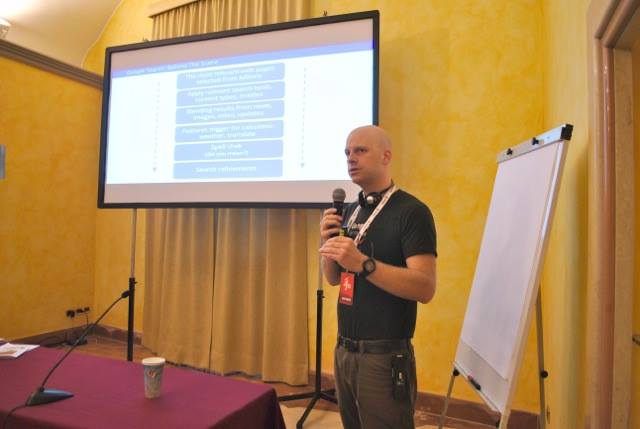
Nicholas Whitaker, media outreach lead at Google and former documentary filmmaker, conducted a workshop on using Google+ and YouTube to enhance journalistic work. During the presentation, held during the International Journalism Festival at the Hotel Brufani, Whitaker revealed that Google+ is not just another social network. It holds plenty of potential that many users simply don’t know how to access and utilize. During his presentation, the Google expert shared insider tips on making your video stand out among others on the popular video hosting service YouTube.
Without further ado, here are 25 secrets for making the most out of Google+ and YouTube:
Google+ has estabslished two groundbreaking technologies for holding online communication: Google Hangouts and Hangouts On Air. A Hangout is a live video conversation which allows to invite up to ten people at once. It’s a private video conference, which is visible only to its participants.
1. Try taking advantage of a Hangout On Air. It’s a live video conversation that can be broadcast to the rest of the world. It’s streamed live to YouTube. After the talk is done, it automatically saves to the video hosting and behaves like a regular upload giving the opportunity to use the ‘Analytics’ function.
2. Besides that, a Hangout On Air can also be used on multiple platforms and can be embedded to any other website. This engages the audience that’s not using Google+ or YouTube. It is a proven fact that embedding video on several different websites helps to drive traffic.
3. Take full control over a Google Hangout conversation by utilizing apps. For example, the ‘Q&A’ app allows you to invite other people (who are not in the Hangout) to participate by leaving their comments. It’s a rather vivid way for the host to interact with a larger audience.
4. Check out the control room app. It came as a result of the collaboration between journalists who provided feedback to the Google+ team. It has many different functions giving the host power to invite more people into the Hangout, one after another, to eject them, or mute the sound or video for the participants who have a slow Internet connection.
5. With ‘The tool box’ app you can create lower thirds, overlays and add logos; basically the Hangout can be customized.
6. To gain more followers Nicholas Whitaker recommends using the built-in feature ‘Communities,’ which is a very strong way to reach people who self-identify themselves as being interested in a particular topic.
7. Try promoting and cross-promoting (before, during and after) your video content (YouTube) and Hangouts (Google+).
8. Whitaker also urges journalists to think about the the technical side of their work. The difference the smallest details can make on the quality of your audio, video, and content in general, can be immense. Therefore, consider the following:
- the bandwidth should not supposed to be lower than 1.5 Mb/s (per person)
- try to use hardwire Internet during online conferences since they tend to be more stable and will give your content a more professional look
- make sure the firewall is off during hang outs because it can slow down the connection
- think about audio first, then the video: the audience will forgive you the bad visuals but will move on if they can’t hear anything.
9. How to upgrade your content quality from amateur to professional? Whitaker shared his improvised shopping list: external camera, portable tripods, microphones, basic lightening kit (clip-on lights for make-up will do just as well). The presenter recommended to be creative when picking your equipment since it doesn’t necessarily have to be expensive.
YouTube is obviously a very powerful platform that has about a billion unique users per month. Nicholas Whitaker shares the following tricks on attracting a larger audience to your video content.
10. Who is your audience? Where are they watching your content? Over what period of time? The YouTube’s ‘Analytics’ product provides answers to these questions and guides you in creating your content.
11. Consider how viewers are consuming your material (currently over 40% of videos are watched from mobile devices).
12. Do not treat YouTube as just a place to deposit your videos, think of it as live environment. Be an active participant, embed your videos, comment in the thread, work with your affiliates.
13. Create branded content for your channel (use customized banners and logos for consistency).
14. Link your social media accounts to your brand page.
15. Organize the videos and information on your channel in a suitable manner (playlists).
16. Pick a format that works best for your particular type of content.
17. Aim to make the content viral (sharable, emotional, topical and with a broad appeal).
18. Create small packaged content.
19. Package your content in the way that it’s easy for the user to find it (titles, keywords, dates).
20. Engage with your audience.
21. Use annotations and calls to action (for example, phrases like ‘comment below’, ‘subscribe to my page’, etc.);
22. Send the same video multiple times.
23. Partner up with trendsetters in your industry.
24. Use different kind of ads and monetize on them.
25. Follow YouTube ‘Trends’ page.
Whitaker concluded the Master Class by stating that these features create a whole eco-system of products which are meant to compliment each other and help their users create the best quality visual content possible.
‘We are really changing the paradigm of communication,’ he said.
By Lillie Mazitova